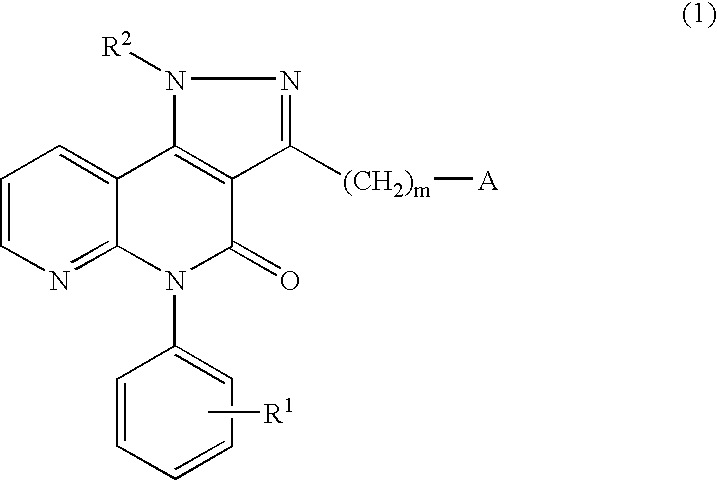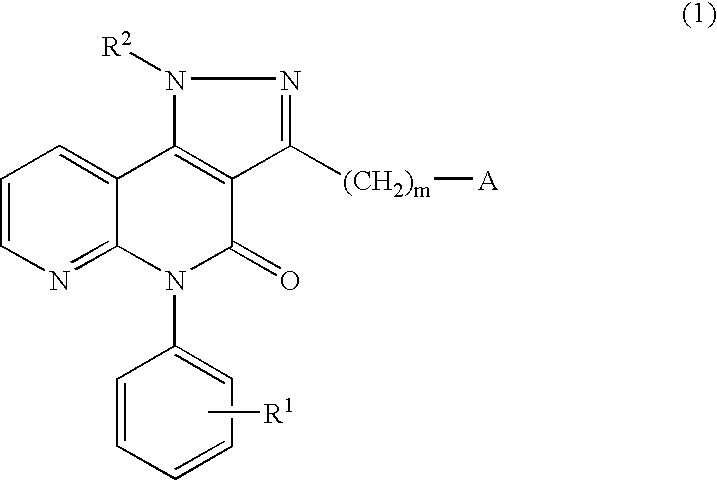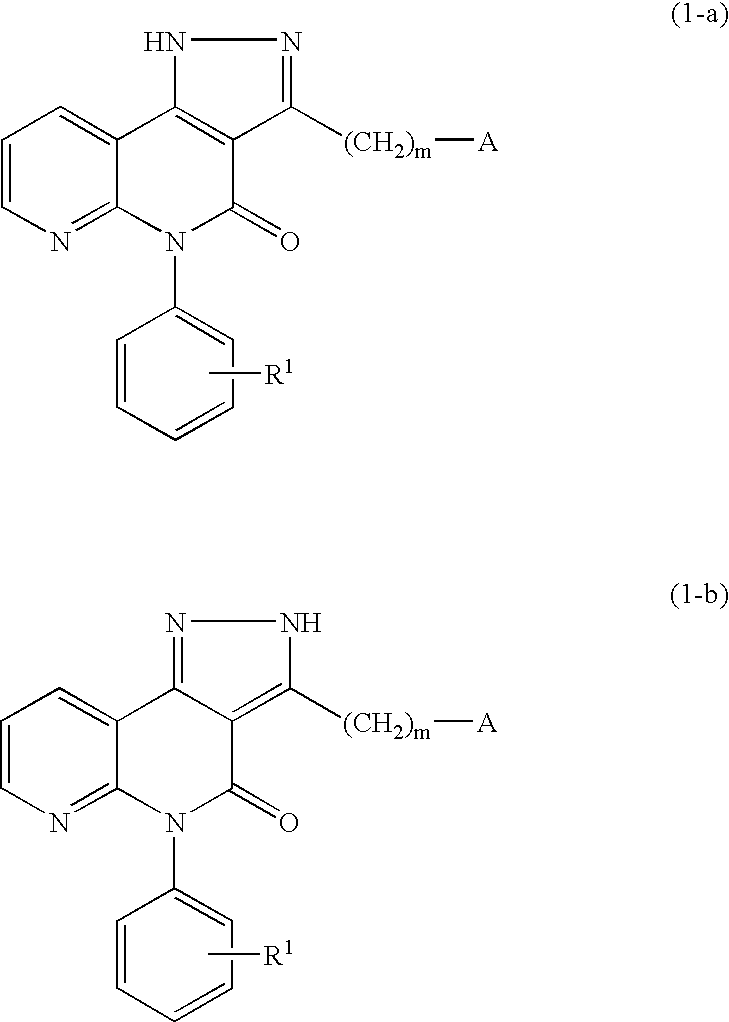Pyrazolonaphthyridine derivative
a technology of pyrazolonaphthyridine and derivatives, which is applied in the field of new drugs, can solve the problems that the above-mentioned compound groups are still unsatisfactory in view of solving problems, and achieve excellent pharmacological effects, suppress the activation of inflammatory cells, and inhibit the activity of inflammatory cells
- Summary
- Abstract
- Description
- Claims
- Application Information
AI Technical Summary
Benefits of technology
Problems solved by technology
Method used
Image
Examples
synthetic example 1
4-hydroxy-3-[1-oxo-3-(pyridin-4-yl)propyl]-1-phenyl-1,8-naphthyridin-2 (1H)-one
[0232] (1) A solution of ethyl 3-(pyridin-4-yl)propionate (17.14 g, 96 mmol; synthesized according to WO, A, 01 / 42244) in aqueous sodium hydroxide (2N, 100 ml) was heated under reflux for 1 hour, cooled, then adjusted pH 4 to 5 with conc. sulfuric acid, filtered to give precipitates which were washed with water, and then with hexane, and dried to afford 3-(pyridin-4-yl)propionic acid (10.15 g, 70%) as crystals.
[0233]1H NMR(DMSO-d6) δ:2.59 (2H, t, J=7.6 Hz), 2.83 (2H, t, J=7.6 Hz), 7.25-7.27 (2H, app-d, J=5.9 Hz), 8.44-8.46 (2H, app-d, J=5.9 Hz), 12.21 (1H, br)
[0234] (2) A mixture of 4-hydroxy-1-phenyl-1,8-naphthyridin-2 (1H)-one (2.0 g, 8.4 mmol; synthesized according to JP, A, 61-246183 (1986)), 3-(pyridin-4-yl)propionic acid (19.03 g, 126 mmol, 15 eq.) and polyphosphoric acid (about 100 ml) was heated overnight at 150° C. while stirring. The mixture was poured into water with stirring to form a solut...
synthetic example 2
4-hydroxy-3-[1-oxo-3-(pyridin-3-yl)propyl]-1-phenyl-1,8-naphthyridin-2 (1H)-one
[0237] (1) A mixture of 3-(pyridin-3-yl)propenoic acid (10.0 g, 67 mmol), 10% palladium-activated carbon (1 g), methanol (100 mL) and ethanol (100 mL) was stirred overnight under hydrogen atmosphere. The resultant reaction mixture was filtered, evaporated, and dried to give 3-(pyridin-3-yl)propionic acid (10.2 g, quantitative).
[0238]1H NMR(DMSO-d6) δ:2.52 (2H, m), 2.81 (2H, t, J=7.6 Hz), 7.27-7.31 (1H, app-dd, J=4.6 Hz, 7.9 Hz), 7.63-7.67 (1H, app-dt, J=7.9H, 1.7 Hz), 8.38-8.40 (1H, app-dd, J=1.7 Hz, 4.6 Hz), 8.44-8.45 (1H, app-d, J=1.7 Hz)
[0239] (2) The procedure of Synthetic Example 1 was repeated using 4-hydroxy-1-phenyl-1,8-naphthyridin-2 (1H)-one (402 mg, 1.7 mmol; synthesized according to JP, A, 61-246183 (1986)), 3-(pyridin-3-yl)propionic acid (3.81 g, 25.2 mmol, 15 eq.) and polyphosphoric acid (10 ml) to afford 4-hydroxy-3-[1-oxo-3-(pyridin-3-yl)propyl]-1-phenyl-1,8-naphthyridin-2 (1H)-one (283...
synthetic example 3
4-hydroxy-3-[1-oxo-2-(pyridin-3-yl)ethyl]-1-phenyl-1,8-naphthyridin-2 (1H)-one
[0242] (1) To a suspension of 2-(pyridin-3-yl)acetic acid-hydrochloride (13.2 g, 75.6 mmol) in ethanol (100 mL) was added a solution (150 mL) of 0.5 mol potassium hydroxide / ethanol, and the mixture was stirred well, then filtered to remove potassium chloride, concentrated, and dried to give 2-(pyridin-3-yl)acetic acid (10.6 g, quantitative).
[0243] (2) The procedure of Synthetic Example 1 was repeated using 4-hydroxy-1-phenyl-1,8-naphthyridin-2 (1H)-one (712 mg, 3.0 mmol; synthesized according to JP, A, 61-246183 (1986)), 2-(pyridin-3-yl)acetic acid (8.23 g, 60 mmol, 20 eq.) and polyphosphoric acid (1 ml) to afford 4-hydroxy-3-[1-oxo-2-(pyridin-3-yl)ethyl]-1-phenyl-1,8-naphthyridin-2 (1H)-one (203 mg, 19%).
[0244] mp 186-188° C.
[0245]1H NMR(CDCl3) δ:4.67 (2H, s), 7.21-7.29 (3H, m), 7.53-7.74 (5H, m), 8.52-8.55 (2H, app-d, J=7.9 Hz), 8.57-8.59 (2H, app-dd, J=1.7 Hz, 4.6 Hz)
PUM
| Property | Measurement | Unit |
|---|---|---|
| temperature | aaaaa | aaaaa |
| structure-activity relationship | aaaaa | aaaaa |
| temperature | aaaaa | aaaaa |
Abstract
Description
Claims
Application Information
 Login to View More
Login to View More - R&D
- Intellectual Property
- Life Sciences
- Materials
- Tech Scout
- Unparalleled Data Quality
- Higher Quality Content
- 60% Fewer Hallucinations
Browse by: Latest US Patents, China's latest patents, Technical Efficacy Thesaurus, Application Domain, Technology Topic, Popular Technical Reports.
© 2025 PatSnap. All rights reserved.Legal|Privacy policy|Modern Slavery Act Transparency Statement|Sitemap|About US| Contact US: help@patsnap.com



